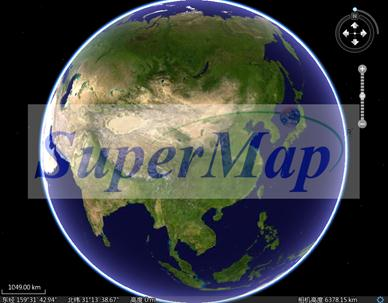In 3D Scene, the data is loaded on the ball and displayed. Like the two-dimensional map, 3D Scene also displays and manages the data in the form of layers. There are three types of layers in a scene: Normal Layer, Screen Layer, and Terrain Layer.
- Normal Layer
Normal Layer is used to load data display. There can be multiple Normal Layers in 3D Scene. Normal Layer can set the style to be saved in the 3D Scene. When the 3D Scene is opened next time, the layer will be automatically loaded into the scene with the style saved last time. The position of objects in the Normal Layer is fixed relative to the sphere. In the scene, it will change with the operation of the ball. For example, when the ball is roamed, the objects in the layer will move with the ball.
Normal Layer is divided into five types: Dataset Type 3D Layer, Map Type 3D Layer, KML Type 3D Layer, Image File Type 3D Layer and Model Cache Type 3D Layer. Details of each type are as follows:
- 3D layer
- of Dataset Type: The 3D layer generated by adding the Dataset in the 2D world to the 3D Scene is collectively referred to as the 3D layer of Dataset Type. Including Vector Dataset, Raster Dataset, Image Dataset;
- Map Type 3D layer: 3D layer generated by Dynamic Projection of 2D map to 3D Scene, collectively referred to as 3D layer of Map Type;
- Image File Type 3D layer: the 3D layer corresponding to the massive Image Data, i.e. Imagery Cache file (*.SCI3D or *.SIT), is loaded to 3D Scene, which is called Image File Type 3D layer here;
- KML type 3D layer: the 3D layer corresponding to the KML data, i.e. *.KML or *.KMZ format file, is loaded to 3D Scene, which is called KML type 3D layer;
- Model Cache Type 3D Layer: The 3D layer corresponding to the Model data, i.e., the Model Cache File (*.SCM), is loaded to the 3D Scene, which is called the Model Layer here.
- Screen Layer
Screen Layer is a special layer that is different from the 3D layer, Terrain Layer, Image Layer, and Tracing Layer described above. The objects in the Screen Layer are not placed on the earth in the 3D Scene according to the coordinate information of the objects, but on the screen (3D window surface). Therefore, the Geometry on the Screen Layer does not change with the rotation, tilt and other operations of the sphere in the 3D Scene. But can be changed along with the change of the three-dimensional window, for example, the corresponding position is changed along with the enlargement and reduction of the three-dimensional window, so that the object on the Screen Layer is static relative to the three-dimensional window, Place content such as Logo, descriptive text, etc. That needs to be displayed still in a 3D window.
A 3D Scene has one and only one Screen Layer. You can add any 3D Geometry to the Screen Layer, set the display position and size of the Geometry, and delete the unnecessary Geometry.
to the Screen Layer in 3D Scene
Figure 1: Adding pictures - Terrain Layer Terrain Data
added to 3D Scene is managed as Terrain Layer. Terrain Data as Terrain Layer is terrain cache file data in the format of *.SCT. In 3D Scene, the functions of adding, deleting and adjusting the order of layers can be realized by managing Terrain Layer through Terrain Layer collection.
SuperMap has powerful 2D and 3D mapping capabilities. Including Unique-values Map, Statistical Thematic Map, complex Thematic Label Map, Graudated Colors Map, Dot Density Map, Thematic map functions such as Graduated Symbols Map, including WYSIWYG free expression function, including rich Marker Symbol Library, line type and surface Fill Style, and accumulated a large number of beautiful two-dimensional Digital Maps. At the same time, 3D Scene can directly project the two-dimensional map to the function of 3D Scene, which is beautiful and more intuitive to show the world.



